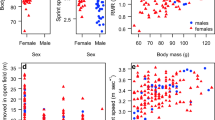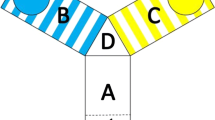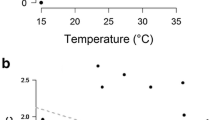Abstract
According to the “pace-of-life syndrome” concept, slow-fast life-history strategies favored under different ecological conditions should lead to co-adaptations between metabolic rate and personality traits such as activity, exploration, and boldness. Although the relationships between resting metabolic rate (RMR) and personality traits have been recently tested several times, we still do not know whether personality is related to the daily energy expenditure (DEE) of free-living individuals in their natural habitat. The objectives of this study were to assess the links between RMR, DEE, and two personality traits (exploration in an open-field and docility during handling) in wild eastern chipmunks (Tamias striatus). Using a multivariate mixed model, we found that exploration and docility were significantly correlated at the among-individual level, confirming the presence of a behavioral syndrome within our population. We also found that exploration, but not docility, was negatively correlated with DEE. Hence, fast explorers show lower DEE levels than slow explorers, independently of RMR and docility. This result adds to an increasingly large (and complex) literature reporting the impacts of personality traits on the biology, ecology, and physiology of animals in their natural environment.

Similar content being viewed by others
References
Archer J (1973) Test for emotionality in rats and mice: a review. Anim Behav 21:205–235
Bergeron P, Careau V, Humphries MM, Réale D, Speakman JR, Garant D (2011) The energetic and oxidative costs of reproduction in a free-ranging rodent. Funct Ecol 25:1063–1071
Bergeron P, Montiglio P-O, Réale D, Humphries MM, Gimenez O, Garant D (2013) Disruptive viability selection on adult exploratory behaviour in eastern chipmunks. J Evol Biol 26:766–774
Berteaux D, Thomas D (1999) Seasonal and interindividual variation in field water metabolism of female meadow voles Microtus pennsylvanicus. Physiol Biochem Zool 72:545–554
Boon AK, Réale D, Boutin S (2008) Personality, habitat use, and their consequences for survival in North American red squirrels Tamiasciurus hudsonicus. Oikos 117:1321–1328
Boratyński Z, Koteja P (2010) Sexual and natural selection on body mass and metabolic rates in free-living bank voles. Funct Ecol 24:1252–1261
Boratyński Z, Koskela E, Mappes T, Oksanen TA (2010) Sex-specific selection on energy metabolism—selection coefficients for winter survival. J Evol Biol 23:1969–1978
Boratyński Z, Koskela E, Mappes T, Schroderus E (2013) Quantitative genetics and fitness effects of basal metabolism. Evol Ecol 27:301–314
Bouwhuis S, Quinn JL, Sheldon BC, Verhulst S (2013) Personality and basal metabolic rate in a wild bird population. Oikos 123:56–62
Boyer N, Réale D, Marmet J, Pisanu B, Chapuis JL (2010) Personality, space use and tick load in an introduced population of Siberian chipmunks Tamias sibiricus. J Anim Ecol 79:538–547
Careau V, Garland T Jr (2012) Performance, personality, and energetics: correlation, causation, and mechanism. Physiol Biochem Zool 85:543–571
Careau V, Thomas D, Humphries MM, Réale D (2008) Energy metabolism and animal personality. Oikos 117:641–653
Careau V, Bininda-Emonds ORP, Thomas D, Humphries MM, Réale D (2009) Exploration strategies map along fast-slow metabolic and life-history continua in muroid rodents. Funct Ecol 23:150–156
Careau V, Thomas DW, Humphries MM (2010) Energetic cost of bot fly parasitism in free-ranging eastern chipmunks. Oecologia 162:303–312
Careau V, Thomas D, Pelletier F, Turki L, Landry F, Garant D, Réale D (2011) Genetic correlation between resting metabolic rate and exploratory behaviour environment in deer mice (Peromyscus maniculatus). J Evol Biol 24:2153–2163
Careau V, Garant D, Humphries MM (2012a) Free-ranging eastern chipmunks (Tamias striatus) infected with bot fly (Cuterebra emasculator) larvae have higher resting but lower maximum metabolism. Can J Zool 90:413–421
Careau V, Réale D, Garant D, Speakman JR, Humphries MM (2012b) Stress-induced rise in body temperature is repeatable in free-ranging eastern chipmunks (Tamias striatus). J Comp Physiol B 182:403–414
Careau V, Bergeron P, Garant D, Réale D, Speakman JR, Humphries MM (2013a) The energetic and survival costs of growth in free-ranging eastern chipmunks. Oecologia 171:11–23
Careau V, Réale D, Garant D, Pelletier F, Speakman JR, Humphries MH (2013b) Context-dependent correlation between resting metabolic rate and daily energy expenditure in wild chipmunks. J Exp Biol 216:418–426
Carere C, Drent PJ, Privitera L, Koolhaas JM, Groothuis TGG (2005) Personalities in great tits, Parus major: stability and consistency. Anim Behav 70:795–805
D’Silva J (2013) Causes of intra-specific variation in metabolic rate in zebrafish, Danio rerio. M.Sc. thesis, University of Ottawa, Ottawa
Dingemanse NJ, Dochtermann NA (2013) Quantifying individual variation in behaviour: mixed-effect modelling approaches. J Anim Ecol 82:39–54
Dingemanse NJ, Dochtermann NA, Nakagawa S (2012) Defining behavioural syndromes and the role of "syndrome deviation" in understanding their evolution. Behav Ecol Sociobiol 66:1543–1548
Dosmann AJ, Brooks KC, Mateo JM (2014) Within-individual correlations reveal link between a behavioral syndrome, condition, and cortisol in free-ranging Belding’s ground squirrels. Ethology 120:1–10
Elliot L (1978) Social behavior and foraging ecology of the eastern chipmunk (Tamias striatus) in the Adirondack mountains. Smithson Contrib Zool 265:1–107
Ferrari C, Pasquaretta C, Carere C, Cavallone E, von Hardenberg A, Réale D (2013) Testing for the presence of coping styles in a wild mammal. Anim Behav 85:1385–1396
Gifford ME, Clay TA, Careau V (2014) Individual (co)variation in standard metabolic rate, feeding rate, and exploratory behavior in wild-caught semiaquatic salamanders. Physiol Biochem Zool 87:384–396
Guenther A, Finkemeier MA, Trillmich F (2014) The ontogeny of personality in the wild guinea pig. Anim Behav 90:131–139
Hadfield JD (2010) MCMC methods for multi-response generalised linear mixed models: The MCMCglmm R package. J Stat Softw 33:1–22
Hadfield JD, Wilson AJ, Garant D, Sheldon BC, Kruuk LEB (2010) The misuse of BLUP in ecology and evolution. Am Nat 175:116–125
Hall CS (1934) Emotional behavior in the rat: defecation and urination as measures of individual differences in emotionality. J Comp Psychol 18:385–403
Hulbert AJ, Else PL (2004) Basal metabolic rate: history, composition, regulation, and usefulness. Physiol Biochem Zool 77:869–876
Humphries MM, Thomas DW, Hall CL, Speakman JR, Kramer DL (2002) The energetics of autumn mast hoarding in eastern chipmunks. Oecologia 133:30–37
Huntingford FA, Andrew G, Mackenzie S, Morera D, Coyle SM, Pilarczyk M, Kadri S (2010) Coping strategies in a strongly schooling fish, the common carp Cyprinus carpio. J Fish Biol 76:1576–1591
Killen SS, Marras S, Ryan MR, Domenici P, McKenzie DJ (2012) A relationship between metabolic rate and risk-taking behaviour is revealed during hypoxia in juvenile European sea bass. Funct Ecol 26:134–143
Koteja P (1996) Measuring energy metabolism with open-flow respirometric systems: which design to choose? Funct Ecol 10:675–677
Krams I, Kivleniece I, Kuusik A, Krama T, Mänd R, Rantala MJ, Znotina S, Freeberg TM, Mänd M (2013) Predation promotes survival of beetles with lower resting metabolic rates. Entomol Exp Appl 148:94–103
Lantová P, Zub K, Šíchová K, Borowski Z (2011) Linkages between metabolism and personality in small mammals—the root vole (Microtus oeconomus) example. Physiol Behav 104:378–383
Larivée ML, Boutin S, Speakman JR, McAdam AG, Humphries MM (2010) Associations between over-winter survival and resting metabolic rate in juvenile North American red squirrels. Funct Ecol 24:597–607
Le Galliard J-F, Paquet M, Cisel M, Montes-Poloni L (2013) Personality and the pace of-life syndrome: variation and selection on exploration, metabolism and locomotor performances. Funct Ecol 27:136–144
Levesque DL, Tattersall GJ (2010) Seasonal torpor and normothermic energy metabolism in the eastern chipmunk (Tamias striatus). J Comp Physiol B 180:279–292
Maldonado K, van Dongen WFD, Vásquez RA, Sabat P (2012) Geographic variation in the association between exploratory behavior and physiology in rufous-collared sparrows. Physiol Biochem Zool 85:618–624
Martin JGA, Réale D (2008a) Animal temperament and human disturbance: implications for the response of wildlife to tourism. Behav Process 77:66–72
Martin JGA, Réale D (2008b) Temperament, risk assessment and habituation to novelty in eastern chipmunks, Tamias striatus. Anim Behav 75:309–318
Martins CIM, Castanheira MF, Engrola S, Costas B, Conceição LEC (2011) Individual differences in metabolism predict coping styles in fish. Appl Anim Behav Sci 130:135–143
Mathot KJ, Martin K, Kempenaers B, Forstmeier W (2013) Basal metabolic rate can evolve independently of morphological and behavioural traits. Heredity 111:175–181
Mathot KJ, Nicolaus M, Araya-Ajoy YG, Dingemanse NJ, Kempenaers B (2014) Does metabolic rate predict risk-taking behaviour? A field experiment in a wild passerine bird. Funct Ecol. doi:10.1111/1365-2435.12318
Montiglio PO, Garant D, Thomas DW, Réale D (2010) Individual variation in temporal activity patterns in open-field tests. Anim Behav 80:905–912
Montiglio PO, Garant D, Pelletier F, Réale D (2012) Personality differences are related to long-term stress reactivity in a population of wild eastern chipmunks, Tamias striatus. Anim Behav 84:1071–1079
Montiglio PO, Garant D, Bergeron P, Dubuc-Messier G, Réale D (2014a) Pulsed resources and the coupling between life-history strategies and exploration patterns in eastern chipmunks (Tamias striatus). J Anim Ecol 93:720–728
Montiglio PO, Garant D, Pelletier F, Réale D (2014b) Intra-individual variability in fecal cortisol metabolites varies with lifetime exploration and reproductive life history in eastern chipmunks (Tamias striatus). Behav Ecol Sociobiol. doi:10.1007/s00265-014-1812-x
Nespolo RF, Bacigalupe LD, Bozinovic F (2003) The influence of heat increment of feeding on basal metabolic rate in Phyllotis darwini (Muridae). Comp Biochem Physiol A 134:141–147
Øverli Ø, Sørensen C, Pulman KGT, Pottinger TG, Korzan W, Summers CH, Nilsson GE (2007) Evolutionary background for stress-coping styles: relationships between physiological, behavioral, and cognitive traits in non-mammalian vertebrates. Neurosci Biobehav Rev 31:396–412
Réale D, Reader SM, Sol D, McDougall PT, Dingemanse NJ (2007) Integrating animal temperament within ecology and evolution. Biol Rev 82:291–318
Réale D, Garant D, Humphries MM, Bergeron P, Careau V, Montiglio PO (2010) Personality and the emergence of the pace-of-life syndrome concept at the population level. Philos Trans R Soc B 365:4051–4063
Ricklefs RE, Wikelski M (2002) The physiology/life-history nexus. Trends Ecol Evol 17:462–468
Schultner J, Welcker J, Speakman JR, Nordøy ES, Gabrielsen GW (2010) Application of the two-sample doubly labelled water method alters behaviour and affects estimates of energy expenditure in black-legged kittiwakes. J Exp Biol 213:2958–2966
Šíchová K, Koskela E, Mappes T, Lantová P, Boratyński Z (2014) On personality, energy metabolism and mtDNA introgression in bank voles. Anim Behav 92:229–237
Speakman JR (1997) Doubly labelled water: theory and practice. Chapman and Hall, London
Speakman JR (1998) The history and theory of the doubly labeled water technique. Am J Clin Nutr 68:932S–938S
Speakman JR (2000) The cost of living: field metabolic rates of small mammals. Adv Ecol Res 30:177–297
Speakman JR, Król E (2005) Validation of the doubly-labelled water method in a small mammal. Physiol Biochem Zool 78:650–667
Speakman JR, Racey PA (1987) The equilibrium concentration of oxygen-18 in body water: Implications for the accuracy of the doubly-labelled water technique and a potential new method of measuring RQ in free-living animals. J Theor Biol 127:79–95
Speakman JR, Racey PA, Haim A, Webb PI, Ellison GTH, Skinner JD (1994) Inter-individual and intra-individual variation in daily energy expenditure of the pouched mouse (Saccostomus campestris). Funct Ecol 8:336–342
Speakman JR, Król E, Johnson MS (2004) The functional significance of individual variation in basal metabolic rate. Physiol Biochem Zool 77:900–915
Terracciano A, Schrack JA, Sutin AR, Chan W, Simonsick EM, Ferrucci L (2013) Personality, metabolic rate and aerobic capacity. PLoS ONE 8:e54746
Timonin ME, Carrière CJ, Dudych AD, Latimer JGW, Unruh ST, Wilis CKR (2011) Individual differences in the behavioural responses of meadow voles (Microtus pennsylvanicus) to an unfamiliar environment are not correlated with variation in resting metabolic rate. J Zool 284:198–205
Walsh RN, Cummins RA (1976) The open-field test: a critical review. Psychol Bull 83:482–504
Wang LCH, Hudson JW (1971) Temperature regulation in normothermic and hibernating eastern chipmunk. Comp Biochem Physiol 31:59–90
Webster DG, Baumgardner DJ, Dewsbury DA (1979) Open-field behavior in eight taxa of muroid rodents. Bull Psychon Soc 13:90–92
Williams JB, Miller RA, Harper JM, Wiersma P (2010) Functional linkages for the pace of life, life-history, and environment in birds. Integr Comp Biol 50:855–868
Wilson RC, Thomas V, Lanier DL, Dewsbury DA (1976) Open-field behavior in Muroid rodents. Behav Biol 17:495–506
Withers PC (1977) Measurements of VO2, VCO2 and evaporative water loss with a flow-through mask. J Appl Physiol 42:120–123
Acknowledgments
We are grateful to the Ruiter Valley Land Trust for allowing us to conduct this research on their property. We thank Z. Boratyński and K. Zub for constructive criticism. We thank P. Bourgault, J.P. Boyer, M. Descôteaux, R. Morin, A. Thomas, M. Landry-Cuerrier, and all field assistants and coordinators who have helped to collect the data. This research was supported by a Fonds Québécois de la Recherche sur la Nature et les Technologies (FQRNT) team grant, by Natural Sciences and Engineering Research Council of Canada (NSERC) discovery grants to Don Thomas, MMH, DR, DG, and FP, and by Canada Research Chair funds to DR and FP. VC and POM were funded by NSERC and FQRNT doctoral scholarships, respectively. We wish to thank the late Don Thomas for his invaluable contribution to this project.
Ethical standards
Animals were captured and handled following the protocol approved by the Animal Welfare Committee of Université de Sherbrooke and the Ministère des Ressources Naturelles et de la Faune du Québec.
Author information
Authors and Affiliations
Corresponding author
Additional information
Communicated by C. Soulsbury
Rights and permissions
About this article
Cite this article
Careau, V., Montiglio, PO., Garant, D. et al. Energy expenditure and personality in wild chipmunks. Behav Ecol Sociobiol 69, 653–661 (2015). https://doi.org/10.1007/s00265-015-1876-2
Received:
Revised:
Accepted:
Published:
Issue Date:
DOI: https://doi.org/10.1007/s00265-015-1876-2




